Gallery
- Cave of Saint Ignatius
- The Church
- Façade
- Church, inside
- Vestibule
- Cave
- Mosaics in the vestibule
- Stained-glass windows
The Cave of Saint Ignatius is a sanctuary declared as a Local Cultural Heritage that includes a baroque church and a neoclassical building in Manresa (Catalonia), which was created to honor the place where, according to tradition, Saint Ignatius of Loyola shut himself in a cave to pray and do penance during his sojourn in the city from March 1522 to February 1523, where he wrote the Spiritual Exercises [1] returning from his pilgrimage to Montserrat. [2]
In 1522, Saint Ignatius of Loyola lived for 11 months in a natural cave. In 1603 a chapel dedicated to Saint Ignatius was built next to the cave. In the 17th century a church was built as a lobby of the cave. Benediction of the church occurred in 1844. From 1894-96 the convent and the house of spirituality were built. In 1915-18, the aisle between the church and the cave was artistically decorated. [3]
The Cave is a natural grotto facing Montserrat and over which the Church, the Jesuit Residence and the Centre of Spirituality are built. In the Cave there is an alabaster altarpiece (second half of the 17th century) that represents Saint Ignatius as penitent, with a pen in his hands and his look towards Montserrat. On the right several alabaster pictures in relief (18th century) can be seen and over one of them there are three crosses carved on the very rock where Ignatius prayed. [1]
Before entering the Cave there is a vestibule, consisting in a spacious aisle designed by Martí Coronas, a Jesuit Brother, at the beginning of the 20th century. Four stained-glass windows in a Venetian mosaic style, bronze relief works, the mosaics and the ceiling are remarkable artistic elements. Two bronze Angels, by artist Llimona, symbolizing Saint Ignatius’ prayer and penance, are over the door of the cave. On the floor can be seen the Loyola house coat of arms, a cannon in remembrance of the Saint’s wound and a big sunflower a symbol of Ignatius’ heart open to Jesus. [1]
The church is a baroque building next to the cave from 1759. [1] It is an example of Jesuit architecture. It is formed by a nave with side aisles and chapels, above which runs tribunes with Baroque lattice. The exuberant baroque façades contrasts with the simplicity of the decorative lines and well proportioned sizes of interior space, and the remarkable unity of style. The Façade of the Church is exuberant Baroque styled, but in a uniformed style and proportioned dimensions. [3]
The convent is a huge neo-Classical building, constructed between 1894 and 1896, where pilgrims from all over the world meet when they come to Manresa to practise the Spiritual Exercises . It also houses an order of Jesuits. [3]

The Church of St. Ignatius of Loyola at Campus Martius is a Roman Catholic titular church, of deaconry rank, dedicated to Ignatius of Loyola, the founder of the Society of Jesus, located in Rome, Italy. Built in Baroque style between 1626 and 1650, the church functioned originally as the chapel of the adjacent Roman College, which moved in 1584 to a new larger building and was renamed the Pontifical Gregorian University.

The Church of the Gesù is the mother church of the Society of Jesus (Jesuits), a Catholic religious order. Officially named Chiesa del Santissimo Nome di Gesù all'Argentina, its façade is "the first truly baroque façade", introducing the baroque style into architecture. The church served as a model for innumerable Jesuit churches all over the world, especially in the Americas. Its paintings in the nave, crossing, and side chapels became models for Jesuit churches throughout Italy and Europe, as well as those of other orders. The Church of the Gesù is located in the Piazza del Gesù in Rome.

Azpeitia is a town and municipality within the province of Gipuzkoa, in the Basque Country, Spain, located on the Urola river a few kilometres east of Azkoitia. Its population is 14,580. It is located 41 kilometres southwest of Donostia/San Sebastián.
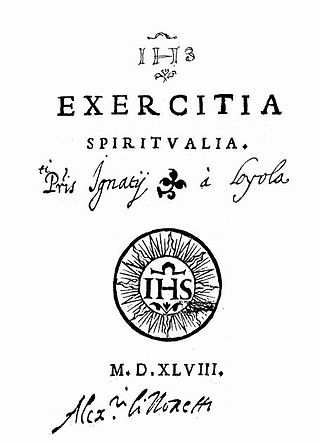
The Spiritual Exercises, composed 1522–1524, are a set of Christian meditations, contemplations, and prayers written by Ignatius of Loyola, a 16th-century Spanish priest, theologian, and founder of the Society of Jesus (Jesuits). Divided into four thematic "weeks" of variable length, they are designed to be carried out over a period of 28 to 30 days. They were composed with the intention of helping participants in religious retreats to discern the will of God in their lives, leading to a personal commitment to follow Jesus whatever the cost. Their underlying theology has been found agreeable to other Christian denominations who make use of them and also for addressing problems facing society in the 21st century.

Our Lady of Montserrat or the Virgin of Montserrat is a Marian title associated with a statue of the Madonna and Child venerated at the Santa Maria de Montserrat monastery on the Montserrat Mountain in Catalonia, Spain. She is the Patron Saint of Catalonia, an honour she shares with Saint George. Miracles have been attributed to the statue.

Manresa is the capital of Bages county, located in the central region of Catalonia, Spain.

Saint Ignatius Church is on the campus of the University of San Francisco (USF) in San Francisco, California. The church serves a parish of the Catholic Archdiocese of San Francisco and is the university's chapel. Saint Ignatius Church is staffed by priests of the Society of Jesus and is dedicated to the Society's founder, Ignatius of Loyola.
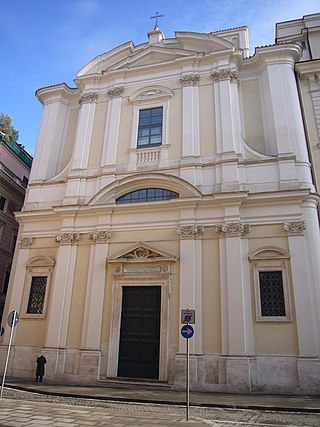
The Basilica di Sant'Apollinare alle Terme Neroniane-Alessandrine is a titular church in Rome, Italy, dedicated to St Apollinare, the first bishop of Ravenna.

The Cathedral Basilica of Salvador, officially dedicated to the Transfiguration of Christ and named Primatial Cathedral Basilica of the Transfiguration of the Lord is the seat of the Archbishop of the city of Salvador, in the State of Bahia, in Brazil. The Archbishop of Salvador is also ex officioPrimate of Brazil. The structure was built by the Society of Jesus as part of a large Jesuit monastic and educational complex. The current church is the built on the site, and was consecrated in 1654. After the expulsion of the Jesuits from Brazil in 1759 the school and church were transferred to the Archbishopric of Bahia. Archbishop Augusto Álvaro da Silva ordered the demolition of the existing cathedral of Salvador in 1933 to construct a tram line, and elevated the existing Jesuit structure to the status of basilica.

Santa Maria de Montserrat is an abbey of the Order of Saint Benedict located on the mountain of Montserrat in Monistrol de Montserrat, Catalonia, Spain. It is notable for enshrining the image of the Virgin of Montserrat. The monastery was founded in 1025 and rebuilt between the 19th and 20th centuries. With a community of around 70 monks, the abbey is still in use to this day.

Ignatius of Loyola, venerated as Saint Ignatius of Loyola, was a Spanish Catholic priest and theologian, who, with six companions, founded the religious order of the Society of Jesus (Jesuits), and became its first Superior General, in Paris in 1541.

The Church of San Felipe Neri, commonly known as "La Profesa", is a Roman Catholic parish church that was established by the Society of Jesus late in the 16th century as the church of a community of professed Jesuits. The church is considered to be an important transitional work between the more sober or moderate Baroque style of the 17th century and the extremely decorated manifestations of the Baroque of the 18th century in Mexico.

The Church of St. Ignatius of Loyola is a Catholic parish church located on the Upper East Side of Manhattan, New York City, administered by the Society of Jesus (Jesuits). The parish is under the authority of the Archdiocese of New York, and was established in 1851 as St. Lawrence O'Toole's Church. In 1898, permission to change the patron saint of the parish from St. Lawrence O'Toole to St. Ignatius of Loyola was granted by Rome. The address is 980 Park Avenue, New York City, New York 10028. The church on the southwest corner of Park Avenue and 84th Street is part of a Jesuit complex on the block that includes Wallace Hall, the parish hall beneath the church, the rectory at the midblock location on Park Avenue, the grade school of St. Ignatius's School on the north midblock location of 84th Street behind the church and the high school of Loyola School at the northwest corner of Park Avenue and 83rd Street. In addition, another Jesuit high school, Regis High School, occupies the midblock location on the north side of 84th Street. The church was added to the National Register of Historic Places on July 24, 1980.

The Temple Expiatori del Sagrat Cor is a Roman Catholic church and minor basilica located on the summit of Mount Tibidabo in Barcelona, Catalonia. The building is the work of the Catalan architect Enric Sagnier and was completed by his son Josep Maria Sagnier i Vidal. The construction of the church, dedicated to the Sacred Heart of Jesus, lasted from 1902 to 1961.

The Museu Comarcal de Manresa is a pluridisciplinary museum created on 2 September 1896 in Manresa and currently located in the old elementary school of Sant Ignasi. It is part of the Barcelona Provincial Council Local Museum Network.
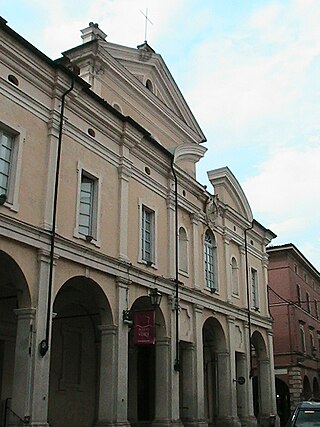
Sant'Ignazio is a Baroque architecture-style Roman Catholic church, located in Busseto, region of Emilia-Romagna, Italy.

Saint Ignatius' Church is a Roman Catholic church situated at the Illuminated Block, in Buenos Aires's neighbourhood of Montserrat. The first building, which was made of adobe, was built by the Society of Jesus in 1675. The southern tower and the present facade were built in 1686, and the rest of the Church construction started in 1712. Today's church was completed in 1722 and consecrated in 1734.

The Chiesa del Gesù is a Catholic church located in Alcamo, in the province of Trapani, Sicily, southern Italy. It is the second largest church in Alcamo, after the basilica di Santa Maria Assunta.
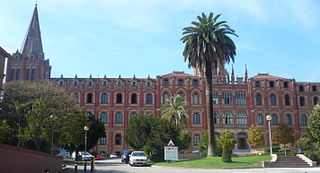
St. Ignatius College is a private Catholic primary and secondary school and vocational training facility, located in the Sarrià neighbourhood of Barcelona, in Catalonia, an autonomous community in the northeastern corner of Spain. The school was founded in 1892 by the Society of Jesus.
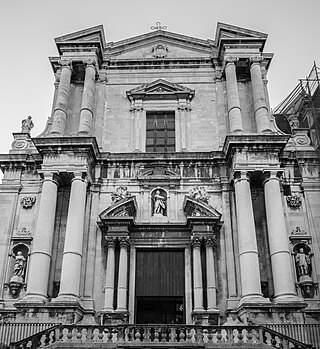
San Francesco Borgia is a Roman Catholic church located on Via Crociferi #7, adjacent to the former Collegio Gesuita, and parallel to San Benedetto, and about a block south on Crociferi of the church and convent of San Giuliano, in the city of Catania, region of Sicily, southern Italy. The church is mainly used for exhibits, but still holds much of the original Jesuit artwork.